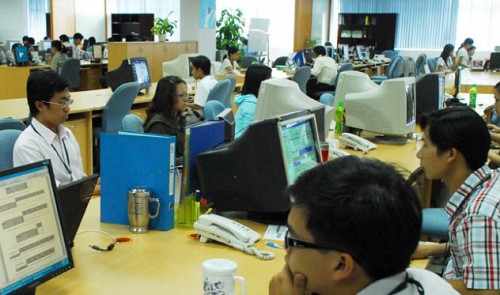
Vinasa said in a recent report that software revenue rose from US$1.06 billion to some US$1.6 billion in the five-year period, and revenue from digital content services reached US$1.6 billion last year.
Labor productivity and production output of the ICT sector are 3-10 times higher than in other sectors.
Vinasa chairman Truong Gia Binh said growth of Vietnam’s software industry in the past five years has slowed due to domestic and global economic woes but still an annual rate of 10-15%.
In the 2011-2015 period, ICT manpower grew by 10% per year.
Over the past five years, domestic demand for ICT products and services has slowed while exports have shot up, especially to the Japanese market. Many companies have even reported revenue growth of up to 100% per year.
According to Binh, economic difficulties have hit domestic demand, mainly for IT application in the state and private sectors due to spending cuts in this field, making growth less as strong as in the 2005-2010 period.
Besides financial constraints, the state sector has faced problems with policies and mechanisms.
On the contrary, enterprises have recorded good growth in outbound sales with annual growth of 30-40% as they have made the most of foreign enterprises shifting software outsourcing contracts from China and India to Southeast Asian countries, including Vietnam.
According to Vinasa, the competitiveness of Vietnam’s ICT has been recognized internationally. Vietnam was among the top ten countries for offshore IT outsourcing in 2014 by Gartner.
HCMC and Hanoi were also among the top 20 outsourcing destinations of Global Services-Tholons in 2010-2015.
Since 2013, Vietnam has become the second biggest software outsourcing partner of Japan after China, data of Japan’s IT promotion agency showed.
In the five-year assessment report, Vinasa mentioned impediments to the development of the sector.
One of the major drawbacks is that most of ICT enterprises are small and do not invest in research and development activities.
They, therefore, are unable to create creative, breakthrough products and services.
In addition, there is no effective coordination among enterprises to enhance their competitiveness, expand their scale and foreign markets and increase their participation in large-scale projects.
The sector lacks manpower in terms of both quantity and quality. ICT firms need to employ around 400,000 people between 2016 and 2020 while 290 universities, colleges and around 150 IT schools nationwide can supply 250,000 of the total. Skills and foreign language competence of fresh graduates are limited.
Labor shortages have led to many employees changing jobs and this has affected enterprises in the sector, sent labor cost up, and made the sector less attractive to investors, according to Vinasa.
Poor infrastructure has also hindered the sector’s development. The country’s large software park Quang Trung Software City houses over 100 enterprises while small and medium enterprises have to lease offices in different parts of the nation.
